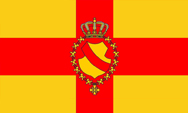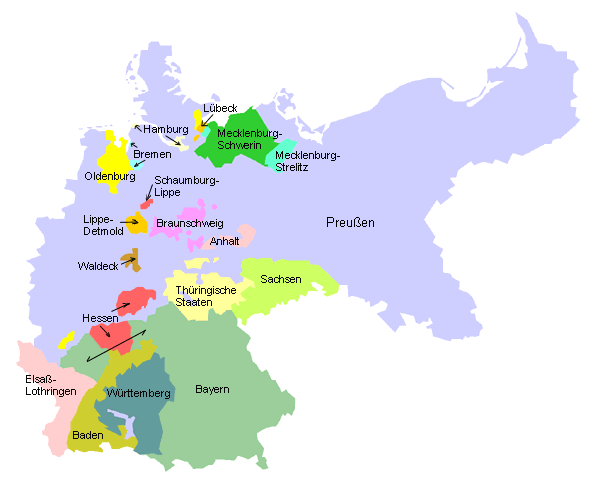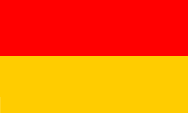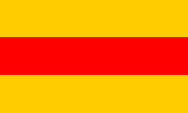



1946–1952,
Official flag of the country,
Source by: Flaggenkunde




1892–1918,
Flag of the Grand Duke,
Source by: Flags of the World






The colours of Baden correspond to the colors of the former ruling dynasty of Baden, the former Margraves of Baden from the House of Zähringen. The Zähringers used a golden shield with a red eagle, the Margraves of Baden, a golden shield with a red diagonal bar.
Another incident for the flag was the seizure of power by the National Socialists in the German Empire in 1933. All official non-swastika flags, that refered to federalism, regional references or the old German Empire were abolished between 1933 and 1935. For the National Socialists, the federal structure of the German Empire, its historically grown countries, was considered as outdated, as relics of a past to be overcome. In this sense, several laws were enacted, on 31st of March in 1933 the 'Provisional Law for the phasing of the countries with the Empire', on 7th of April 1933 the 'Second Law for the phasing of the countries with the Empire' and finally, on 30th January in 1934 the 'Law on the rebuilding of the empire'. Thus, the federal structure of the German Empire was replaced by the gau-structure of the NSDAP, the countries became meaningless. From now on, offices and authorities had to use the swastika flag as official flag, until September 15th in 1935, when by the flag-law was legislated a new created official flag for all the offices and authorities of the empire. The prime ministers of the countries, which latest in 1933 all came from the NSDAP – now mostly called Reichsstatthalter (maybe translated as 'governor') – however remained in office until 1945. The corresponding country colours continued, with restrictions, but definitly not in the form of flags. They were used, for example, occasionally on uniforms of the SA or in some ranks of the Hitler Youth in the breast cord.
After the war, the administration within the German Empire was rebuilt, but locally, following the structure of the countries. These have been partly old countries, and some new countries were created. Sometimes they bethought the old country colours and reactivated them – or they created new ones – for limited sovereign duties, which were under the control of the Allies. With the founding of the FRG and the GDR, an internal country-structure was finalised for both entities and corresponding official flags were introduced for these countries.
Source: Volker Preuß, Jürgen Kaltschmitt, Uniform-Fibel


1946–1952, Coat of Arms,
Source by: Flaggenkunde

The coat of arms of Baden is known since the 12th century. It shows a golden shield with a red diagonal bar. The Margraves of Baden came out of the House of the Zähringers, which used a red eagle on golden background. The design of the coat of arms of Baden goes probably back to the coat of arms of the Zähringers. The division of the house into the lines of Baden-Baden (Catholic) and Baden-Durlach (Protestant), influenced not the design of the coat of arms. It was used by the two lines as small arms or heart-shield within the large, dynastic coat of arms.
Source: by Heraldique Europeenne


1807, Cockade

1813, Cockade, Mounted volunteer riflemen

1807, Cockade

1807, Cockade
In the Napoleonic period, only officers and sergeants of the State of Baden wore cockades at the shako. The authors know nothing more about the coloration and design of the blanket between the end of the Napoleonic era and the end of the monarchy in the year 1918.
Source:
Jürgen Kaltschmitt, by
1) P. Bunde - Brigade-Uniformtafel Nr. 140, Herzogenrath 2004
2) P. Schuchhardt, "Compagnie d' Elite" Uniformtafel Nr. 19, Gütersloh 2001
3) P. Bunde - Brigade-Uniformtafel Nr. 324, Herzogenrath 2010

read here:
Informations, history and facts about the theme "Cockades".

Cockade

Federal Countries of the German Empire 1871 to 1920 (all names and designations in German):

Source: Volker Preuß

Borders to 1945,
Quelle: mhoefert.blogspot.com
und Ssch / CC BY-SA

Borders 1946–1952,
Quelle:
mhoefert.blogspot.com
und No machine-readable author provided. Flosch assumed (based on copyright claims). / CC BY-SA

Area: 5.818 square miles
Inhabitants: 2.500.000 (1939)
Capital: Karlsruhe
Currency to 1875: 1 Gulden = 60 Kreuzer
Currency 1875–1924: 1 Mark = 100 Pfennig
Currency 1924–1948: 1 Reichsmark (RM) = 100 Reichspfennig (Rpf.)
Source: Wikipedia (D),
Der Michel

1061 · Hermann I., half-brother of the Duke of Swabia (from 1100 Duke of Zehringen, becomes the Margrave of Verona
1112 · Hermann I., is first mentioned as Margrave of Baden, born of the House of Baden
1535–1771 · partition: 1st: Margrave County of Baden-Baden (catholic), 2nd: Margrave County of Baden-Durlach (evangelical)
1771 · extinguish of the sovereign-lineage of Baden-Baden, Baden-Durlach rules over whole Baden
1803 · Electorate of Baden
1806 · Grand Duchy of Baden
1848/49 · republican riotings
1866 · in the German War on the side of the German Confederation (Austria)
1870 · joining to the North German Federation
1871 · joining to the German Empire
1918 · fall of the monarchy, free state
1945 · partition of the country: 1st: North Baden, with parts of Wuerttemberg, → Country of Wuerttemberg-Baden, 1949–1952 federal country of the FRG, 2nd: South Baden, → until 1949 Country of Baden, 1949–1952 federal country of the FRG
Source: Atlas zur Geschichte,
Wikipedia (D),
RetroBib Retrobibliothek,
Discovery '97

The name "Baden" points out to the town of Baden (Baden-Baden), namesake of the Marquisate of Baden, which appeared in the middle of the 12th century. The word "Baden" ("bath") refers to the existing hot springs there, which were already known by the Romans as a bathing place, which they called "Aquae Aureliae" (Bath of Aurelius).
Source: Handbuch der geographischen Namen







![]()




















